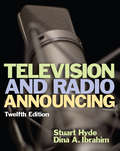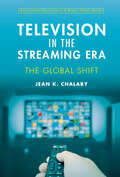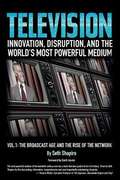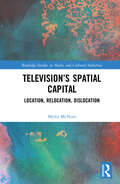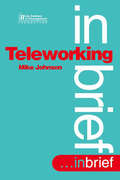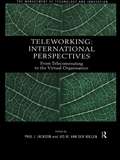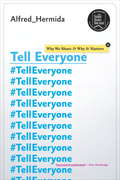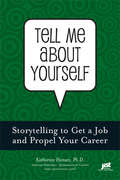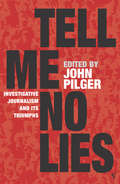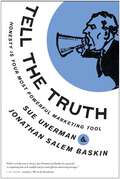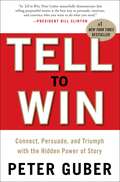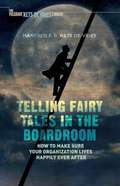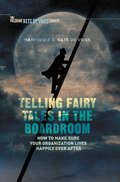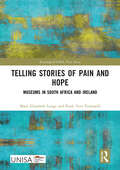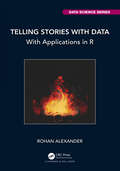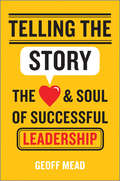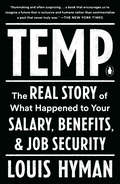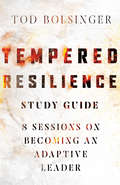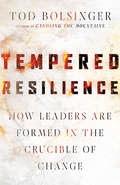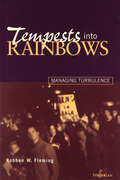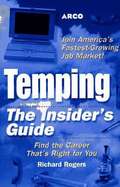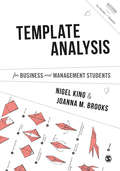- Table View
- List View
Television and Radio Announcing: Text With Audio Cd
by Stuart HydeThe digital revolution has significantly changed broadcast technology. The 12th edition of Television and Radio Announcing reflects new trends in the field, such as the reconfiguration of electronic media production practices and distribution models. The internet and social media have opened up new access to production and new methods of distribution, such as YouTube, Facebook, Twitter, and podcasts. The 12th edition addresses the realities of students who live in this new era. Learning GoalsUpon completing this book, readers will be able to: Develop essential announcing skills Understand new trends in the field
Television in the Streaming Era: The Global Shift (Development Trajectories in Global Value Chains)
by Jean ChalabyThis ground-breaking study explores transformations in the TV industry under the impact of globalizing forces and digital technologies. Chalaby investigates the making of a digital value chain and the distinct value-adding segments which form the new video ecosystem. He provides a full account of the industry's global shift from the development of TV formats and transnational networks to the emergence of tech giants and streaming platforms. The author takes a deep dive into the infrastructure (communication satellites, subsea cable networks, data centres) and technology (cloud computing, machine learning and artificial intelligence) underpinning this ecosystem through the prism of global value chain theory. The book combines empirical data garnered over 20 years of researching the industry and offers unique insights from television and tech executives.
Television: The Broadcast Age and the Rise of the Network
by Seth ShapiroNo medium in history can match the power of television. No product has spread so far and so fast. Nothing has had so much influence. Nothing has impacted how the world sees itself like television. TELEVISION: Volume 1 brings together seven decades of stories on how this happened into one epic narrative. How did an impoverished immigrant become the king of all media, creating the first radio network and the first TV network? What caused the inventor of FM radio to jump out of a window to his death? How did NBC, CBS and ABC innovate to build their media monopolies? How did Star Trek create the first fan culture movement? What made The Mary Tyler Moore Show the first great feminist show, and #1 hit? What made Norman Lear the most influential TV comedy producer ever? How did Lucille Ball go from a washed-up B movie actress to a multi-millionaire Hollywood studio mogul? What makes Louis C. K. the Jackie Gleason of the digital age? With unparalleled insider insight, it shares critical, practical, behind the scenes lessons from the business of TV. The TELEVISION series is a must-read for media executives, students, entrepreneurs, and fans. Two-time Emmy(R) Award winner, author Seth Shapiro is a leading advisor in business innovation, media and technology. He is an Adjunct Professor at the USC School of Cinematic Arts, a Governor of the Television Academy, and Principal of New Amsterdam Media LLC.
Television’s Spatial Capital: Location, Relocation, Dislocation (Routledge Studies in Media and Cultural Industries)
by Myles McNuttThis book launches a comprehensive detailing of the dramatic expansion of the geography of television production into new cities, states, provinces, and countries, and how those responsible for shaping the "landscape" of television have been forced to adapt, taking established strategies for engaging with space and place through mediated representation and renegotiating them to account for the new map of television production. Modeling media studies research that considers the intersection of production, textuality, distribution, and reception, Myles McNutt identifies how the expansion of where television is produced has intersected with the kinds of places represented on television, and how shifts in the production, distribution, and consumption of television content have shifted the burden of representing cities and countries both locally and internationally. Through a combination of industry interviews, textual analysis, and in-depth consideration of industry and audience discourse, the book argues that where television takes place matters more today than it ever has, but that the current system of spatial capital remains constrained by traditional industry logics that limit the depth of engagement with place identity even as the expectation of authenticity grows significantly. Representing a cross section of media industry studies, television studies, and cultural geography, this book will appeal to scholars and students within multiple areas of media studies, including production studies and audience studies, in addition to television studies broadly.
Teleworking (Im In Brief Ser.)
by Mike JohnsonFrom the people who work exclusively from home to the 'portable' manager with no fixed site, the need to communicate is paramount. Mike Johnson's candid appraisal of teleworking, or telecommuting as it is also known, looks at the key benefits: for the individual it provides the opportunity to work from home; for the company it provides major savings on costs. The down side is the lack of human contact and the anxiety of employees who work away from the centre of things. The ...in brief books provide a critical 'snapshot' of the major management fashions and fads influencing business strategy. They cut through the consultants' jargon and steer a practical, common sense course through the theory and hype. They provide managers with a balanced view based on evidence rather than missionary zeal, so that they can be better informed.
Teleworking: New International Perspectives From Telecommuting to the Virtual Organisation (Studies In The Management Of Technology And Innovation Ser.)
by J. Jackson Jos M. Van Der WielenTeleworking is an up-to-date, groundbreaking and comprehensive assessment of teleworking. It includes * multidisciplinary contributions drawing on sociology, management science, economics, philosophy and information technology* analysis of post-modern and post-industrial theoretical contexts* a selection of empirical studies from across the world* accounts of different modes of teleworking, from homeworking to centre-based working* examination of the links between teleworking and the virtual organisationWide-ranging, detailed and original, this book is a valuable introduction to teleworking and an important contribution to the debate on the future of the labour market.
Tell Everyone
by Alfred HermidaIdeas and stories that would once only reach a handful of people can now reverberate across the world, amplifying the power of individuals, informing our choices, and changing how we receive and react to the news. Tell Everyone explores and explains a more open, vibrant and diverse media Every day more than 500 million messages are sent on Twitter, 800 million people share four billion stories, links, photographs and videos on Facebook. Every minute, 100 hours of video is uploaded to YouTube. And the flow is ever-increasing. In this new era of media saturation, what do we mean by "the news"? Is "the most trusted name in news" today a veteran anchor on television or an undergraduate tweeting from Tahrir Square in Cairo? The day before yesterday, news and information was scarce, coming from a few newspapers or broadcasters. Now, not only are we able to connect and collaborate to create our own media, but for the first time have access to a global audience. Together we can help to bring down governments or chasten international corporations. We can hasten the spread of gossip, rumour and lies. We can market our products more widely and efficiently than ever--if we take the trouble to discover why people share and to whom. In this groundbreaking work, online news pioneer and social media maven Alfred Hermida examines how our ability to create and share news is shaping the information we receive and depend on to make informed decisions, from choosing politicians to doing business. Drawing on historical examples, real-world experiences and leading research, he equips us with the knowledge and insight to navigate successfully the social streams of information that shape how we view the world.--a more open, vibrant and diverse media.
Tell Me About Yourself
by Katharine HansenIntroduces storytelling as the key to excelling in other job search activities, such as writing resumes and cover letters, networking, creating portfolios, and developing a personal brand. Readers learn how to execute these crucial steps impressively and successfully. Hansen also teaches readers how to use storytelling on the job to capitalize on opportunities to advance throughout their career.
Tell Me No Lies: Investigative Journalism and its Triumphs
by John PilgerTell Me No Lies is a celebration of the very best investigative journalism, and includes writing by some of the greatest practitioners of the craft: Seymour Hersh on the My Lai massacre; Paul Foot on the Lockerbie cover-up; Wilfred Burchett, the first Westerner to enter Hiroshima following the atomic bombing; Israeli journalist Amira Hass, reporting from the Gaza Strip in the 1990s; Gunter Wallraff, the great German undercover reporter; Jessica Mitford on 'The American Way of Death'; Martha Gelhorn on the liberation of the death camp at Dachau. The book - a selection of articles, broadcasts and books extracts that revealed important and disturbing truths - ranges from across many of the critical events, scandals and struggles of the past fifty years. Along the way it bears witness to epic injustices committed against the peoples of Vietnam, Cambodia, East Timor and Palestine. John Pilger sets each piece of reporting in its context and introduces the collection with a passionate essay arguing that the kind of journalism he celebrates here is being subverted by the very forces that ought to be its enemy. Taken as a whole, the book tells an extraordinary 'secret history' of the modern era. It is also a call to arms to journalists everywhere - before it is too late.
Tell Tchaikovsky the News: Rock ’n’ Roll, the Labor Question, and the Musicians’ Union, 1942–1968
by Michael James RobertsFor two decades after rock music emerged in the 1940s, the American Federation of Musicians (AFM), the oldest and largest labor union representing professional musicians in the United States and Canada, refused to recognize rock 'n' roll as legitimate music or its performers as skilled musicians. The AFM never actively organized rock 'n' roll musicians, although recruiting them would have been in the union's economic interest. In Tell Tchaikovsky the News, Michael James Roberts argues that the reasons that the union failed to act in its own interest lay in its culture, in the opinions of its leadership and elite rank-and-file members. Explaining the bias of union members--most of whom were classical or jazz music performers--against rock music and musicians, Roberts addresses issues of race and class, questions of what qualified someone as a skilled or professional musician, and the threat that records, central to rock 'n' roll, posed to AFM members, who had long privileged live performances. Roberts contends that by rejecting rock 'n' rollers for two decades, the once formidable American Federation of Musicians lost their clout within the music industry.
Tell The Truth: Honesty Is Your Most Powerful Marketing Tool
by Jonathan Salem Baskin Sue UnermanTruth is a powerful marketing tool—and really the only way to promote a message and brand effectively. Truth in advertising has long been something to ignore, or at least downplay. The role of advertising has been to position and manipulate brands to convince consumers that they're imbued with qualities they don't necessarily possess, or presume to tell them which ones matter. It worked when the brand's voice was the only voice, but with the rise of social media that era is over. Marketers have focused their messages on entertainment, creating funny or engaging campaigns that win awards but don't always sell products. Consumers determine what's true, and smart companies have realized that every communications medium can and will be used to contribute to those conclusions. In Tell the Truth, Jonathan Baskin and Sue Unerman look at the content and context of marketing communications. They provide the research of hundreds of companies and in-depth case studies on more than 50 global brands to show us that truthful brands deliver sales, profits, and sustainable relationships. Truth truly yields true competitive advantage.
Tell to Win: Connect, Persuade, and Triumph with the Hidden Power of Story
by Peter GuberToday everyone -- whether they know it or not -- is in the emotional transportation business. More and more, success is won by creating compelling stories that have the power to move partners, shareholders, customers, and employees to action. Simply put, if you can't tell it, you can't sell it. And this book tells you how to do both. Historically, stories have always been igniters of action, moving people to do things. But only recently has it become clear that purposeful stories -- those created with a specific mission in mind -- are absolutely essential in persuading others to support a vision, dream or cause. Peter Guber, whose executive and entrepreneurial accomplishments have made him a success in multiple industries, has long relied on purposeful story telling to motivate, win over, shape, engage and sell. Indeed, what began as knack for telling stories as an entertainment industry executive has, through years of perspiration and inspiration, evolved into a set of principles that anyone can use to achieve their goals. In Tell to Win, Guber shows how to move beyond soulless Power Point slides, facts, and figures to create purposeful stories that can serve as powerful calls to action. Among his techniques: *Capture your audience's attention first, fast and foremost *Motivate your listeners by demonstrating authenticity *Build your tell around what's in it for them *Change passive listeners into active participants *Use state-of-the-heart technology online and offline to make sure audience commitment remains strong. To validate the power of telling purposeful stories, Guber includes in this book a remarkably diverse number of voices -- master tellers with whom he's shared experiences. They include YouTube founder Chad Hurley, NBA champion Pat Riley, clothing designer Normal Kamali, Mission to Mars scientist Gentry Lee, Under Armour CEO Kevin Plank, former South African president Nelson Mandela, magician David Copperfield, film director Steven Spielberg, novelist Nora Roberts, rock legend Gene Simmons, and physician and author Deepak Chopra. After listening to this extraordinary mix of voices, you'll know how to craft, deliver -- and own -- a story that is truly compelling, one capable of turning others into viral advocates for your goal.
Telling Fairy Tales in the Boardroom: How to Make Sure Your Organization Lives Happily Ever After
by Manfred F. R. Kets de VriesWe know where we are with a fairy story. There is a cast of predictable characters, the hero or heroine is submitted to terrible trials, cruelty, and injustice but in the end the baddies get their comeuppance, good triumphs, and everyone lives happily ever after. In this book Manfred Kets de Vries, one of the world's leading authorities on the psychology of leadership, and a pioneering practitioner in the field of psychodynamic executive coaching, draws on the format of traditional fairy tales and tells us five stories that dramatize five key themes of dysfunctional leadership.
Telling Fairy Tales in the Boardroom: How to Make Sure Your Organization Lives Happily Ever After (INSEAD Business Press)
by Manfred F.R. Kets de VriesWe know where we are with a fairy story. There is a cast of predictable characters, the hero or heroine is submitted to terrible trials, cruelty, and injustice but in the end the baddies get their comeuppance, good triumphs, and everyone lives happily ever after. In this book Manfred Kets de Vries, one of the world's leading authorities on the psychology of leadership, and a pioneering practitioner in the field of psychodynamic executive coaching, draws on the format of traditional fairy tales and tells us five stories that dramatize five key themes of dysfunctional leadership. The accompanying commentaries analyze each tale and examine the ways in which it applies to leadership behavior and organizational practices. This diagnostic element is supported by self-assessment tests that reinforce the main lessons of each tale and guide the reader's interpretation of the results. With Kets de Vries's guidance you'll be able to help your clients create best places to work, where everyone is the best they can be, and lives 'happily ever after'.
Telling Stories of Pain and Hope: Museums in South Africa and Ireland (ISSN)
by Ruth Teer-Tomaselli Mary Elizabeth LangeThe histories of South Africa and Ireland have been tumultuous and traumatic. Both countries have experienced political repression, sectarian violence and oppression that still impact the spiritual well-being of people today. Their parallel histories are of colonialism, displacement and division, and a fight for land and sovereignty. Both countries have embarked on a process of healing and reconciliation, yet there is an ongoing struggle for reparation and/or reversal of previous injustices.Recognising that museums of the 21st century have the potential to contribute to catharsis and mutual understanding, this book reflects on selected museums in South Africa and Ireland that commemorate the pain of the past and the hope for the future. The primary focus of the book is the way in which museum guides, curators and managers share their stories and the stories of their ancestors, and the stories of other people’s ancestors who were caught up in the conflict while interweaving the stories of the authors as well.Print edition not for sale in Sub Saharan Africa.
Telling Stories with Data: With Applications in R (Chapman & Hall/CRC Data Science Series)
by Rohan AlexanderThe book equips students with the end-to-end skills needed to do data science. That means gathering, cleaning, preparing, and sharing data, then using statistical models to analyse data, writing about the results of those models, drawing conclusions from them, and finally, using the cloud to put a model into production, all done in a reproducible way. At the moment, there are a lot of books that teach data science, but most of them assume that you already have the data. This book fills that gap by detailing how to go about gathering datasets, cleaning and preparing them, before analysing them. There are also a lot of books that teach statistical modelling, but few of them teach how to communicate the results of the models and how they help us learn about the world. Very few data science textbooks cover ethics, and most of those that do, have a token ethics chapter. Finally, reproducibility is not often emphasised in data science books. This book is based around a straight-forward workflow conducted in an ethical and reproducible way: gather data, prepare data, analyse data, and communicate those findings. This book will achieve the goals by working through extensive case studies in terms of gathering and preparing data, and integrating ethics throughout. It is specifically designed around teaching how to write about the data and models, so aspects such as writing are explicitly covered. And finally, the use of GitHub and the open-source statistical language R are built in throughout the book. Key Features: Extensive code examples. Ethics integrated throughout. Reproducibility integrated throughout. Focus on data gathering, messy data, and cleaning data. Extensive formative assessment throughout.
Telling the Story
by Geoff MeadHow to master the art of narrative leadershipTelling the Story shows how leaders affect our understanding of what is possible and desirable through the stories they tell. It opens a door into the world of narrative leadership: what stories are and how they work; when to tell a story and how to tell one well; and how the language and metaphors we use influence our actions and change how we think about the world. * Explains how narrative leadership shapes and defines what's possible on an organizational level* Written by a renowned consultant on the art of narrative leadership* Challenges leaders to consider how narrative can influence and help create the kind of society they envision
Telling the WE Story--Leading for the Common Good and Practicing the Art of Leadership
by Rosamund Stone Zander Benjamin ZanderMore often than not, history is a record of conflict between Us and Them. We see this pattern expressed across a broad spectrum: from nation to nation, among political parties, between labor and management, and in the most intimate realms of our lives. Is there an alternative framework that would allow the transformation of us AND those whose claims on resources, territory, and the "truth" are irreconcilable with ours? Can we invent a new way of being that will take us from an entrenched posture of hostility to one of enthusiasm and deep regard? As the authors describe in this chapter, if we set aside the story of fear, competition, and struggle that have defined our world, a WE appears. "WE" personifies the togetherness of all people. If we think about the story of WE, and what is best for all of US, things begin to look very different, and a new kind of leadership emerges. This chapter was originally published as Chapter 12 of "The Art of Possibility: Transforming Professional and Personal Life."
Temp: How American Work, American Business, and the American Dream Became Temporary
by Louis HymanThe untold history of the surprising origins of the "gig economy" --how deliberate decisions made by consultants and CEOs in the 50s and 60s upended the stability of the workplace and the lives of millions of working men and women in postwar America.Every working person in the United States asks the same question, how secure is my job? For a generation, roughly from 1945 to 1970, business and government leaders embraced a vision of an American workforce rooted in stability. But over the last fifty years, job security has cratered as the postwar institutions that insulated us from volatility--big unions, big corporations, powerful regulators--have been swept aside by a fervent belief in "the market." Temp tracks the surprising transformation of an ethos which favored long-term investment in work (and workers) to one promoting short-term returns. A series of deliberate decisions preceded the digital revolution and upended the longstanding understanding of what a corporation, or a factory, or a shop, was meant to do.Temp tells the story of the unmaking of American work through the experiences of those on the inside: consultants and executives, temps and office workers, line workers and migrant laborers. It begins in the sixties, with economists, consultants, business and policy leaders who began to shift the corporation from a provider of goods and services to one whose sole purpose was to maximize profit--an ideology that brought with it the risk-taking entrepreneur and the shareholder revolution and changed the very definition of a corporation.With Temp, Hyman explains one of the nation's most immediate crises. Uber are not the cause of insecurity and inequality in our country, and neither is the rest of the gig economy. The answer goes deeper than apps, further back than downsizing, and contests the most essential assumptions we have about how our businesses should work.
Tempered Resilience Study Guide: 8 Sessions on Becoming an Adaptive Leader
by Tod BolsingerLeadership leads to vulnerability that requires the security of relationships to endure. Tempered Resilience: How Leaders Are Formed in the Crucible of Change is about forming resilience so leaders can lead through the resistance that always accompanies change. Tod Bolsinger, an organizational and pastoral leader, writes that experiencing resistance leaves us feeling "exposed, unsure, and often discouraged." Honest and supportive relationships are key to flourishing in these moments of vulnerability. Thus the sessions in this guide are designed to lead to honest conversations for self-discovery as well as offering practices that leaders and their teams can take on together. Following the structure of review, reflect, relate, and practice, this guide for both individuals and groups will help you to forge the kind of tempered and resilient leadership that the times demand.
Tempered Resilience: How Leaders Are Formed in the Crucible of Change
by Tod BolsingerWhat type of leadership is needed in a moment that demands adaptive change? Tod Bolsinger, author of Canoeing the Mountains, is uniquely positioned to explore the qualities of adaptive leadership in contexts ranging from churches to nonprofit organizations. He deftly examines both the external challenges we face and the internal resistance that holds us back. Bolsinger writes: "To temper describes the process of heating, holding, hammering, cooling, and reheating that adds stress to raw iron until it becomes a glistening knife blade or chisel tip." When reflection and relationships are combined into a life of deliberate practice, leaders become both stronger and more flexible. As a result, these resilient leaders are able to offer greater wisdom and skill to the organizations they serve. Also available: Tempered Resilience Study Guide
Tempests into Rainbows: Managing Turbulence
by Robben W. FlemingRobben W. Fleming was President of the University of Michigan during the turmoil of the Vietnam era. He brought a clear and effective philosophy to the challenges he faced as manager and leader in a turbulent time. Fleming recounts the dramatic confrontations and demonstrations at Michigan over the war in Vietnam, military research in universities, the investment of university endowment funds in South African enterprises, and black student campaigns for improved conditions on campus. Robben W. Fleming has much to teach. There are lessons for all who face the challenges of leadership in this lively and readable autobiography of one who has displayed grace, style and effectiveness in difficult and sometimes threatening situations. Tempests into Rainbows also explores the influences on his life that nurtured his exceptional ability to create agreement and to solve conflict. The story of his formative years is filled with both humor and pathos. Fleming writes about local personalities, the deaths of his "twin" brother and father, and the difficulties of the family during the economic recession of the 1920s and 1930s. Academic and athletic prowess enabled him to put himself through college and law school, emerging just in time to serve as a military government officer with troops in North Africa and Europe. After World War II, Fleming became a specialist in labor-management relations, teaching at the University of Illinois and serving as a professional mediator and arbitrator of labor disputes. Then in 1964 he became Chancellor of the University of Wisconsin in Madison, and later President of the University of Michigan until 1979. Although he remains active as a consultant deploying his mediation skills, his last career position was as President of the Corporation for Public Broadcasting. This unusual autobiography, appealing in its honesty and in the original story it has to tell, is also instructive in showing how a thoughtful person with a humane, consistent philosophy can manage when chaos and turmoil threaten. It will thus appeal not only to those who knew Fleming and who have ties to the universities in which he served, but also to all who manage and study the management of complex institutions. "Robben Fleming has written a fascinating memoir, especially his intensely personal account of the trials and terrors that faced this university president as Ann Arbor's student body--and he came to grips with the civil rights revolution and the Vietnam War." ---Mike Wallace "To relive Robben Fleming's life is to relive an American epoch. There was a time when America was at war with its enemies, and a time when America was at war with itself. He writes perceptively from both battlegrounds." ---Daniel Schorr "Robben Fleming is a giant--a creative and imaginative leader of exceptional talent. All of us can learn from the lessons of his life. His book is a treasure." ---Newton N. Minow
Temping: The Insider's Guide
by Richard Rogers"Get the inside scoop on the temp track: how to choose a temporary agency; salaries and benefits; your responsibilities to the agency and the client; professional temp positions; getting on the agency's "A" list; and much, much more."--BOOK JACKET. Title Summary field provided by Blackwell North America, Inc. All Rights Reserved
Template Analysis for Business and Management Students (Mastering Business Research Methods)
by Professor Nigel King Dr Joanna BrooksPart of SAGE’s Mastering Business Research Methods, conceived and edited by Bill Lee, Mark N. K. Saunders and Vadake K. Narayanan and designed to support researchers by providing in-depth and practical guidance on using a chosen method of data collection or analysis. In Template Analysis for Business and Management Students Nigel King and Joanna Brookes guide you through the origins of template analysis and its place in qualitative research, its basic components, and the main strengths and limitations of this method. Practical case studies and examples from published research then guide you through how to use it in your own research project. Ideal for Business and Management students reading for a Master’s degree, each book in the series may also serve as a reference book for doctoral students and faculty members interested in the method. Watch the editors introduce the Mastering Business Research Methods series and tell you more about the first three books.
Template Analysis for Business and Management Students (Mastering Business Research Methods)
by Professor Nigel King Dr Joanna BrooksIn Template Analysis, Nigel King and Joanna Brookes guide you through the origins of template analysis and its place in qualitative research, its basic components, and the main strengths and limitations of this method. Practical case studies and examples from published research then guide you through how to use it in your own research project. Ideal for Business and Management students reading for a Master’s degree, each book in the series may also serve as a reference book for doctoral students and faculty members interested in the method. Part of SAGE’s Mastering Business Research Methods, conceived and edited by Bill Lee, Mark N. K. Saunders and Vadake K. Narayanan and designed to support researchers by providing in-depth and practical guidance on using a chosen method of data collection or analysis. Watch the editors introduce the Mastering Business Research Methods series.
